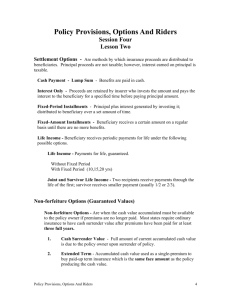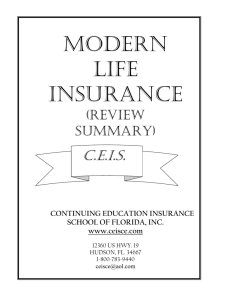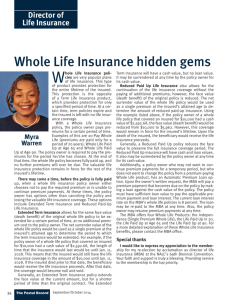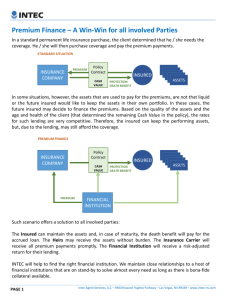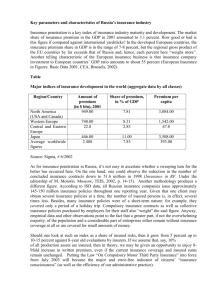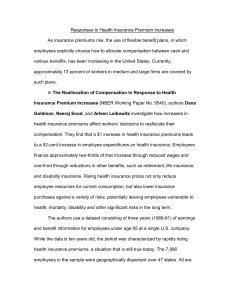chapter three - whole life insurance
advertisement
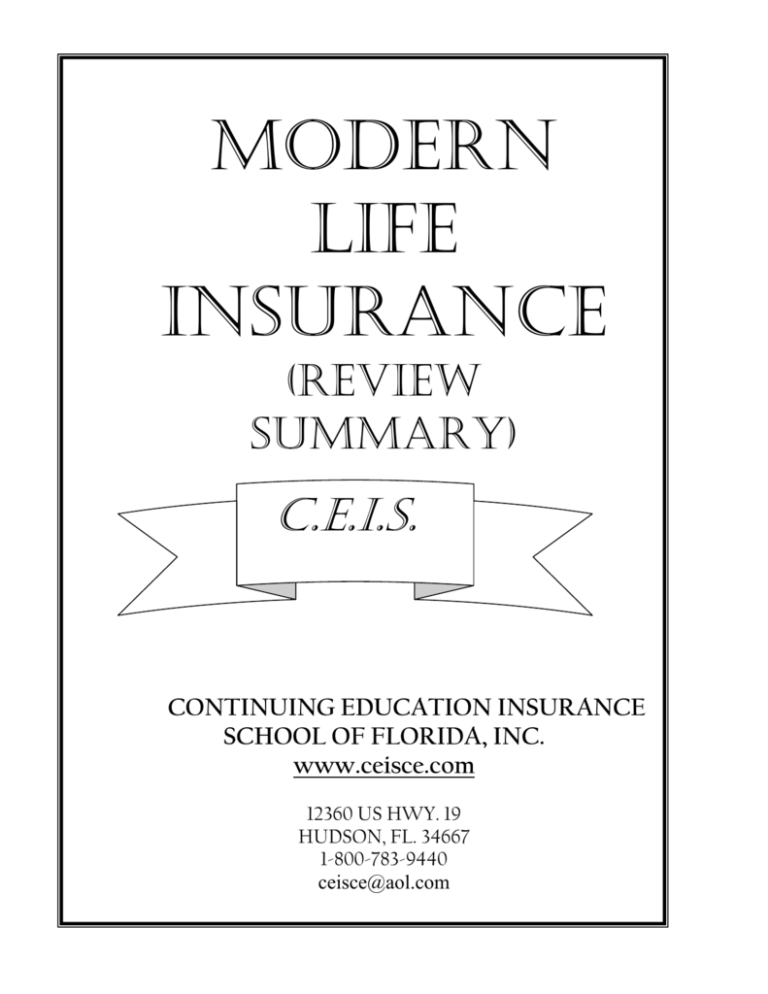
MODERN LIFE INSURANCE (Review SUMMARY) C.E.I.S. CONTINUING EDUCATION INSURANCE SCHOOL OF FLORIDA, INC. www.ceisce.com 12360 US HWY. 19 HUDSON, FL. 34667 1-800-783-9440 ceisce@aol.com 1 CHAPTER ONE BASICS OF LIFE INSURANCE DEFINITION OF LIFE INSURANCE Solomon Huebner, the grand old man of the life insurance industry, stated in “Life Insurance, a Textbook” written in 1914: “Mankind is exposed to may serious hazards such as fire, disability and premature death, the happening of which, from the standpoint of the individual, it is impossible to foretell or prevent, but the effect of which, such as the loss of propert y or earning, it is highl y important to provide against. If the hazard under consideration is that of premature death, the loss suffered is indemnified through life insurance. ACCUMULATING A FUND FOR PAYMENT OF CLAIMS While all forms of insurance are alike in that they required for their successful operation a combination of many risks in a group, they are vitall y different as regards the nature of the risks covered. In this respect, the chief difference between life and other forms of insurance is that in the latter the contingency insured against may or may not happen, and as regards the great majorit y of policies written, does not happen, while in life insurance the event against which protection is granted, namel y death, is a “hazard converging into certaint y.” Since life insurance policies promise a definite sum in the event of death, and in some instances in the event of survival at a s tated time, it is essential that there be an accurate determination of the liabilit y involved and that an adequate premium be charged which is just as between ages and t ypes of policies. Life insurance presents a further problem as regards the accumulati on of the fund necessary to pay policy claims. A workable plan of life insurance required the charge of a uniform annual premium during the premium -paying period. Simpl y put, a life insurance policy is composed of a series of one -year renewable term (annu al renewable term) and each year’s premium just covers the cost of the protection. Under this simple plan, however, as each person ages, the premiums soon become prohibitive with the result that the healthy members of the group will withdraw rather than continue to pay the greatl y increased rates. In order to overcome a problem —the premium must be increased with age —during the earl y years, the company accumulates sufficient funds over and above the cost of current insurance. This “overcharge” does not bel ong to the company but is held in trust with the insurer for the benefit of the insured at an assumed rate of interest for this purpose. POOLING OF THE RISK There are many other definitions of Life Insurance but the “spreading of risk” and the “transfer of risk” are the two most common and most accurate in discussing life insurance in today’s societ y. 2 The very basic element of these definitions is the pooling of risks, the sharing of losses by members of a group. There are various ways to share the risk in Life Insurance, but principall y it is an arrangement where the members of the group “insure” each other, or the risk is transferred to an organization that assumes the risk and pays the losses of the group. For this purpose of this discussion, the ver y heart, the “essence,” of life insurance —indeed, all insurance plans —is the pooling of the risks and losses. POLICY PROVISIONS First, it should be understood that a life insurance policy is a legal contract, and as such, legal terminology is the most co rrect way to address the subject. The terms of the contract are drawn up by the insurer, and the policyholder either accepts the terms or not. A t ypical application informs the applicant that the agent cannot alter the wording or any provision in the poli cy. For the applicant, it is a take -it or leave-it proposition. STANDARD POLICY PROVISIONS The standard policy provisions laws of the various states require that life insurance policies include certain provisions but allow the insurance companies to selec t the actual wording with the proviso that the wording is approved to the State Department of Insurance. REQUIRED PROVISIONS Grace Period The grace period clause grants the policyowner an additional period of time to pay any premium after it was due. POLICY LOANS An insurer is required by law to allow policy loans if the policy provides for cash values. A loan on the policy simpl y transfers money to the policyowner with the obligation that it is simpl y an advance to the policyowner from the cash valu e of the policy. Another form of loan is the automatic premium loans that are advances that the insurer makes to the policyowner from the policy cash value to pay the unpaid premiums. INCONTESTABLE CLAUSE The National Association of Insurance Commissioner s Standard Policy Provisions Model Act and the state laws based upon the Model, require that the policy contain an incontestable clause, a provision that makes the life insurance policy incontestable by the insurer after it has been in force for a certain time period. 3 REINSTATEMENT Reinstatement provisions allow a policyowner to reacquire coverage under a policy that has lapsed. The various state laws and the insurance contracts impose certain requirements that the policyowner must meet to reinstate the policy. A t ypical reinstatement statement requires the insurer to reinstate within a specified period (usuall y three years) and the policy has value and the policyowner applies and provides evidence of insurabilit y, and pays back premiums and interest, et c. MISSTATEMENT OF AGE OR SEX Obviousl y, since life insurance premiums are based upon the age of the insured, and in many cases the sex of the insured, if these factors are inaccurate, it would be a material misrepresentation. The insurer would t ypical l y adjust the premiums and benefits to reflect the correct age and sex. Adjustments to the policy’s premiums and/or benefits are usuall y the actions taken by the insurer. NONFORFEITURE PROVISIONS When insurers developed the concept of level premium insu rance policies, the goal was to make life insurance affordable to elderl y policyholders. Standard Nonforfeiture laws. These laws require that after a cash value policy has been in effect for a minimum number of years—usuall y three—the insurer must use pa rt of the reserved excess premium to create a guaranteed minimum cash value. OPTIONAL PROVISIONS In addition to the required provisions, there are numerous other provisions that are not required nor are they prohibited. SUICIDE PROVISION Typicall y, a death by suicide is not covered for a specified period —usuall y two years, sometimes one year. OWNERSHIP PROVISION Ordinaril y the insured is the applicant and owner of the policy and certain rights are necessaril y spelled out. Typicall y, the policy states that the owner of the policy is the insured unless the application states otherwise. 4 ASSIGNMENT PROVISION In keeping with normal rights of property owner, the policyowner may transfer some or all of his or her rights to another person. ACCELERATION OF BENEFITS The AIDS epidemic was the catal yst for this provision, plus public concern about other terminal illnesses. This provision permits the insured to withdraw death benefits under certain specific conditions. This also applies to situations where t he insured is terminall y ill whereby the policyowner can withdraw part of the death benefit. ADDITIONAL COMMON PROVISIONS Other common policy provisions are those concerning accidental death benefits, the guaranteed purchase option (also known as the gua ranteed insurabilit y option), and the waiver of premium in the event of the insured's disabilit y. ACCIDENTAL DEATH BENEFITS This optional policy provision is added to some insurance contracts in the form of a rider, or amendment, to the policy and is also known as the double indemnit y provision because it normall y doubles the standard death benefit if the insured dies accidentall y. DEFINITION OF ACCIDENTAL DEATH Because this benefit is payable onl y in the event of the insured's accidental death, many policies define “accident,” and “accidental death.” There are two t ypes of accidental death clauses: (1) the accidental result t ype and (2) the accidental means t ype. The most common t ype of provision in life insurance policies is the accidental result category. This is more favorable to the consumer, further, most courts have recognized that the difference between the two clauses is too difficult for many consumers to understand and have therefore ceased to recognize a distinction between the two t ypes of cla uses. The distinction can be explained as follows: under an accidental means clause both the cause (means) of the death and the result must be unintentional. Under an accidental result clause, onl y the result must be unintentional. GUARANTEED PURCHASE OPTION (GPO) The guaranteed purchase option is quite popular – also known as the guaranteed purchase option. This is a relativel y new provision. It protects policyowners against the possibility that they might become uninsurable, right when they need and want to purchase added coverage. The GPO give the policyowner the right to acquire additional insurance in specified amounts at specified times or ages —such as allowing additional purchases every 3 years and after the birth of a child — provided the events o ccur before the insured reaches a specified maximum age (often 45). The right to purchase additional insurance can be very valuable because the insured does not have to provide evidence of insurabilit y to exercise the option. 5 CHAPTER TWO - TERM INSURANCE BASICS OF TERM INSURANCE Term insurance provides protection for only a specified and limited period, and if the insured dies during the period while the insurance is in force the beneficiary will receive the death benefit amount. If, however, the insured survives to the end of the insured period, the policy terminates and there is nothing paid to the insured. Term insurance is, obviously, temporary insurance, and in many ways is comparable to types of property and casualty insurance. In auto and home owners insurance, for example, premiums paid for the protection are considered as fully earned (at the end of the policy year) whether there is a loss or not, and the policy has no further value once the policy term has been completed. Renewing a Term Policy Many, if not most, term insurance policies have an option to renew for a specified period or periods of time, which generally are all the same length of time. The YRT policy is renewable for successive one-year periods. Term policies for longer periods of time—10-20 years typically—usually are renewable under certain stipulations. Convertibility Besides offering renewability, most term policies are also convertible —permitting a policyowner to exchange the term policy to a permanent type of insuranc e without evidence of insurability. Convertibility is more important that renewability as it guarantees access to a permanent plan, not just to coverage or continuation of temporary protection. There are two types of convertibility: attained age and ori ginal age. With the attained age conversion, the premiums for the permanent plan would be based upon the age of the policyowner at which the conversion occurs. The original age conversion (also called “retroactive conversion”) uses the original date of the term policy and premiums on the permanent insurance would be based upon the age of the policyowner when he was first insured under the term policy. RE-ENTRY TERM Because the element of adverse selection is so troublesome, insurance companies invented a term insurance policy that charges higher premiums to those of poor health when they renew their term insurance, ergo; the degree of adverse selection is reduced. THE PLACE OF TERM INSURANCE IN TODAY’S MARKET Even though term insurance may be the oldest form of life insurance, except possibly the assessment plans, it still has a place in today’s societies. There are those who maintain that all life insurance should be term insurance as it fills all life insurance needs. 6 WHEN TERM INSURANCE SHOULD BE USED It is obvious that there are two areas where term insurance may be or should be used. Since term insurance provides temporary protection, then that is one of the areas where it should be used—to provide temporary protection. The second area where term insurance is suitable is when the need for insurance may be permanent, but the insured simply cannot afford permanent insurance to provide the coverage needed. OBJECTIONS TO OTHER FORMS OF INSURANCE The most often used—and the easiest to explain to a prospect—reason not to buy permanent plans is that it is more expensive. A person buys life insurance so as to leave money to his beneficiaries in case he dies early or during his income -producing years and that should be the only purpose of life insurance. The basic argument is that why should anyone pay in advance for something that they may not need or live to enjoy? Term insurance, however, is a method of “paying as you go and you get what you paid for.” BUY TERM - INVEST THE DIFFERENCE The “buy term and invest the difference” philosophy as extolled by some, needs further consideration and discussion as it is based upon the proposition that individuals can invest their funds as efficiently and profitably as can the insurer, and usually at a higher r ate of return. Those who preach the “buy-term-and-invest-the-difference” philosophy use this argument, and therefore they recommend that an individual buy term insurance and the difference in what they would have paid for level premiums, they can invest in a separate program. All investments have their place in an individual’s financial and/or estate planning programs but life insurance is normally the very foundation of such a program or plan, and rightfully so. CHAPTER THREE - WHOLE LIFE INSURANCE PRINCIPAL TYPES OF WHOLE LIFE INSURANCE Ordinary life insurance is a t ype of whole life insurance that requires premiums for the entire life of the insured. Permanent Protection Basicall y, the term of insurance is always there so that policy does not have to be renewed or converted. Just as long as the policyholder pays the premium, the coverage is there for as long as premiums are paid. 7 Limited-payment insurance contracts provide benefits that justify the higher premium rates. Policy Loans Policyowners have cash values at their disposal for all level premium life insurance policies such as whole life, universal life, adjustable life, variable life, variable universal life, and current assumption whole life —all have provisions for policy loans. Policy loans simpl y provide a cash value access to the policyholder without having to terminate the policy. When the loan and/or accrued interest are not paid to the insurer in cash, the insurer can withhold such funds from the death benefits if the ins ured dies or from the cash surrender value if the policy is terminated. It must be kept in mind that a policy loan, per se, is simpl y an advance against the death benefit, therefore the death benefit is adjusted to reflect the previous disbursement. When the insured dies, the death benefit is reduced by the full amount of outstanding policy loans and accrued interest under most t ypes of policies. Nonforfeiture or Surrender Options. One of the most important contract provisions with whole life is the n onforfeiture options—also known as surrender options. Basicall y there are three surrender options—cash, reduced amount of paid -up whole life insurance, or paid -up term insurance. Cash Value. Standard wording states that the policy may be surrendered at a ny time for its cash value, then the protection terminates and the company has no further obligation under the policy. Reduced Amount of Paid-Up Whole Life. The amount of the policy is the amount that could be purchased at the attained age of the insured which would be the net cash value —cash value less any policy indebtedness (such as policy loans and interest) plus any dividend accumulation as the original policy. Paid-Up Term. A no t he r ( t he t hi r d ) o p t i o n p r o v i d e s p a i d - up t e r m i ns u r a nc e i n a n a m o u nt e q ua l t o t he o r i g i na l f a c e a m o u nt o f t he p o l i c y , p l us d i v i d e nd a d d i t i o n s o r d e p o s i t s a n d r e d u c e d b y a n y p o l i c y i nd e b t e d ne s s . T he l e ng t h o f t he c o nt r a c t w o ul d b e w ha t c a n b e p ur c ha s e d a t t he i ns ur e d ' s a t t a i ne d a g e w i t h t he ne t c a s h va l ue a p p l i e d a s a ne t s i ng l e p r e m i um . Limited-Payment Life Insurance The policyholder pays a premium for a predetermined number of years and he keeps his policy for the rest of his life. 8 The Face Amount This policy has a death benefit that is guaranteed to stay level for as l ong as the policyowner owns it, even up to age 100. The face amount is usuall y paid out income tax free to the beneficiary. It can be paid in one lump sum or in the form of a monthl y income. ADJUSTABLE LIFE INSURANCE As young families looked toward the future, particularl y their children’s educational needs, it was apparent that a famil y’ s financial needs varied throughout their lifetime. Life insurers were particularl y sensitive to this need —after all, providing funds for the future is what they do —and they introduced whole life insurance that can be adjusted when needed during the life of the policy, hence, the Adjustable Life Insurance policy was born. Adjustable Life policies have the same guarantees as cash value, mortalit y and expenses as regular whole life, but the premiums, face amount and cash value are subject to change. CURRENT ASSUMPTION WHOLE LIFE INSURANCE A current assumption whole life (CAWL) provides a “bridge” between traditional insurance and interest sensitive “new generation” products. In effect, a CAWL is called “interest sensitive whole life” by some, and call ed “indeterminate -premium whole life” by others. The policy will use interest rates that reflect the new -money rates and will also use the current mortality charges in determining the cash value. Because CAW L policies are “unbundled,” much like Universa l Life, there is a stated allocation of premium payments and interest earnings to the mortalit y charges, expenses and cash values. To be specific, the premiums paid are designated expense charges, and the remainder is a (net) addition to the policy fund t hat is added to the previous policy fund balance and any interest (at the current rate) that has accumulated on the fund. From this fund total, a mortalit y charge is levied, and the remaining amount is the year -end fund balance. This balance, less any st ipulated surrender charges, would be the net surrender value if the policy were to be surrendered. GROUP LIFE INSURANCE Group life insurance is an important part of the life insurance industry, accounting for about 40% of all life insurance in force by amount with an average certificate of $32,000. GROUP INSURANCE REQUIREMENTS While groups eligible for insurance coverage can cover a wide variet y of professions, industries, etc., there are, at times, questions as whether loosel y joined groups of people qualify as a “group” for insurance purposes. It is “etched in stone” that a group cannot be qualified for group insurance if the group was been formed for the purpose of obtaining insurance. 9 Participants Generall y, onl y active, full -time employees are eligible for group coverage . Probationary Period Employees usuall y have a probationary period, usuall y one to six months, during which they are not eligible for coverage. Coverage Period The coverage period is usuall y the length of time that the employe e remains with the employer (assuming the plan stays in force with the employer and the employee pays their share of the premium, if any). Benefit Amount Typicall y, the employee does not specify the benefit amount and the amount is usuall y (1) a set amou nt for all employees, (2) a percentage of the employee’s income with the employer, (3) an amount that is designated for the position the employee holds (job title), or (4) a function of the employees length of service. . Type of Insurance Group life ins urance is basicall y yearly renewable term insurance. Employee Contributions For contributory plans, employee contributions are usuall y at a set rate per $1,000 of coverage at all ages. In most states, employers are required to pay at least a portion of the premium. CHAPTER FOUR - VARIABLE INSURANCE POLICIES VARIABLE LIFE INSURANCE A predecessor to Universal Life Insurance is Variable Life Insurance, introduced in 1976, which shifts the investment risk to the policyholders. A variable life insuran ce policy provides no guarantees of either interest rate or minimum cash value. Theoreticall y, the cash value can go down to zero, and if so, the policy will terminate. SEC Objections to Variable Life There were two main obstacles in gaining SEC approv al of variable life products. The first one was the maximum compensation to agents for the sale of this product as the SEC wanted the sales load not to exceed 8 percent of the sale price . Another problem was whether insurance companies would be permitted to allow flexible premium payments under these policies. 10 In the beginning, variable life insurance policies gave the purchaser (insured) three investment options into which the funds could be directed —whether all or a distribution in whatever portions d esired among the options. Typicall y, there was a minimum requirement of at least 5 or 10 percent of incoming funds had to be allocated to any investment option the policyowner selected. The minimum requirement was supposed to eliminate the chance that ad ministrative costs would exceed the amount of money being directed into a particular option. The options were usuall y a stock fund, a bond fund, and either a treasury fund or a money market fund. VOLATILITY OF VARIABLE PRODUCTS Those who are experienced in equit y investments may be comfortable with the variable life insurance policy. For those without such experience, the dail y portfolio fluctuations can provoke great anxiet y in individuals who are not used to or comfortable with such market value fluct uations. Increased Number of Investment Fund Options It should not be surprising that variable life insurance policy designs have not been static since their introduction with the result that life insurance companies are now offering many more investment fund options made available in the earl y stages of this product's development. Some insurance companies have more than 4 dozen funds to choose from in their current product offering, consisting of a wide variet y of stock funds, including growth stock fun ds, income stock funds, balanced stock funds, and international stock funds. Many insurance companies offer a managed fund as one of the portfolio choices. The policyowner can put all of the policy funds in a managed portfolio fund and have the investment allocation decisions made by a professional money manager working for the insurance company. THE PROSPECTUS Variable life insurance policies cannot be sold without providing a prospectus similar to that required by stock issues. The prospectus is a full disclosure of all of the provisions of the contract including expenses, investment options, benefit provisions, the policyowner rights under the contract. Purchasers should take the time to read the entire document even if it is rather lengthy and th ey should be aware that it contains information that they could not receive elsewhere. POLICYOWNER ASSUMED RISKS As stated earlier, fixed premium variable life insurance contracts are very similar to whole life insurance contracts – the principal difference is the policyowner assumes reinvestment risk and therefore can participate in favorable investment returns. This provision does not allow the policyowner to increase or decrease the death benefits by negotiated adjustment – if results are favorable, it is automaticall y translated into increased death benefits amounts. 11 The policy does guarantee a minimum death benefit level that is equal to the original face amount of the contract, regardless of the investment performance. UNIVERSAL LIFE INSURANCE Universal Life insurance was introduced in the 1970s and had been sold in Europe. Companies in the United States were desperate to have such a plan. The big problem was with the problem of non -forfeiture laws that are regulated so as to eliminate such a plan unless it is sold as a noninsurance product that would then bring the SEC into the marketing and accounting of life insurance. In the late 70’s three well -known and respected actuaries met at an insurance/reinsurance forum in Monaco and were able to dis cover an acceptable solution—hence Universal Life was born. It was the first variation of whole life insurance that could offer trul y flexible premiums and also include adjustment provisions similar those contained in Adjustable Life. FLEXIBLE PREMIUMS The trul y unusual feature of Universal Life was the completely flexible premiums after the first policy year —the onl y time a minimum level of premium payments for Universal Life insurance policy is required. Therefore, the first year’s premium can be arraigned on a monthl y, quarterl y, semiannual or annual basis. FUNDING CHOICES With the introduction of Universal Life insurance, the investment risk to the policyowner was shifted to the policyowner and as such they had to make determination of the amoun t, if any, of pre-funding. One choice is to pay maximum premiums and maintain a very high cash value, or, on the other hand, the policyowner can pay minimum premiums, which just barel y will cover mortalit y and expense charges because there is so little up front or no pre -funding. Even though insurance companies must predict with some amount of accuracy future interest rates investment returns, their very future depends upon policies’ cash values if they are going to return part of the premium to policyhold ers. If they are not, the insurer then may need to keep all the investment returns, and might still have difficult y meeting the problems in the contract. Therefore, it just makes good sense to have more premium money collected upfront, further delaying th e collection of funds, in the hope that economic conditions will be better in the future. POLICY LOANS There is a differential crediting rate on the cash value of Universal Life policy, which depends on whether or not there are policy loans outstanding. If the policyowner borrows funds from the cash value, then the insurer credits a lower 12 interest rate or earnings rate to the portion of the cash value associated with the policy loan. This is another effort to curb disintermediation. Any outstanding policy loans when the insured dies reduces the death benefit by the amount of the loan plus any unpaid interest of the loan —the same for Universal Life policies and for any life insurance policy that has policy loans. LIFETIME FLEXIBILITY Probabl y the most attractive feature of Universal Life policies, when you come down to it, is not necessaril y the fact that the policyowner now has the abilit y to share in excessive interest earnings but primarily the flexibilit y of premiums that have to be paid under the p olicies. Life insurance policies now can keep pace with the needs of the policyowners without "programming" various assumptions. The policy can be funded heavil y when premium dollars are available and conversel y, they can be suspended when the budget get s tight or new expenses arise (such as tuition). INDEXED UNIVERSAL LIFE The indexed product first started with fixed annuities —called Equit y Indexed Annuit y— then spread to the Universal Life insurance policy, and they are now holding hands as they tried to make inroads to a whole life policy. The indexed Universal Life policies have basicall y all the features of a non –indexed Universal Life policy but it also has a minimum interest crediting rate guarantee, therefore they are classified as fixed rather than variable life insurance contracts by the SEC and therefore, are not subject to securities regulation by the federal government. The indexed feature adds the possibility of enhanced crediting rates linked to the performance of a specific stock index such as Standard & Poor's 500. Insurance companies usuall y provide a lower guaranteed interest rate under the index universal policy than their standard Universal Life policies, and the reduction can range from 50 to 150 basis points. Therefore the index ed feature must overcome this reduction before the policyholder receives a positive net benefit from the contract. During periods of poor stock market performance, the indexed Universal Life policy will most likely underperform the standard Universal Lif e policy. Marketing promotions for the indexed products emphasize interest guarantee plus potential enhancement of the crediting rate from stock index increases. This may seem to be, and is often stated, the best of both worlds as there is a guaranteed minimum performance but still the chance to participate when the stock market goes up. VARIABLE UNIVERSAL LIFE INSURANCE This is one of the most recentl y developed t ypes of whole life policies as it incorporates all of the flexibilit y and policy adjustmen t features of Universal Life with the policyowner directing the investments of variable life insurance. Fixed premium features of the variable life insurance contract are not present in this policy. 13 Variable Universal Life offers policyholder a choice amo ng a particular group of mutual funds management of separate accounts, usuall y created and maintained by the insurance company. Some insurance companies have made arrangements with other investment companies to use separate account portfolios that have be en created and maintained by these investment management firms. Basicall y, many of the separate funds are simpl y copies of popular mutual funds available to other investors. FLEXIBILITY Variable Universal Life offers the maximum in both flexibility with the policyholder and the amount of the risk has been shifted to the policyowner. Variable Universal Life contracts are not designed for or should be even desirable for policyowners who do not want to assume the risk of investments under the contract. The policyowner who says they want to assume the investment risk would become very anxious over any short -term fall in the value in the particular investment portfolio they have selected, and they would be wise to exercise caution. COMPARING LIFE INSURANCE POLICY COSTS NET COST There are a wide variet y of methods used to compare life insurance policies and usuall y, the net cost method is the most understood and used. The way that works is rather simple, easy-to-understand and actuall y even easy to calcu late. The steps are to determine a starting point that is a specification of the duration of coverage to be evaluated–usuall y 10 or 20 years of coverage. Then the actual mechanics of this process involves taking all the net premiums paid under the policy , adding them altogether, subtracting the cash surrender value for the time -frame being considered, and all dividends paid over that period. One of the reasons this method is so easy to understand is that it does not take into account the time value of mo ney, e.g., it ignores interest. THE COMPARATIVE INTEREST RATE METHOD There are other comparison methods that utilize and assume a cost of coverage. Creating an interest rate for comparison purposes will also illustrate the problems of comparing any life insurance policy because there are degrees of freedom in the parameters involved. The comparative method looks for the interest rate that would make the buy-term-and-invest-the-difference comparison exactly equivalent in the provided death benefits. The only way that can be accomplished would be for the premiums and side funds to be exactly equal to the death benefit. The problem with this method is that it requires a large amount of data input and a sophisticated computer program in order to accurately determine the interest rate needed. 14 CHAPTER FIVE - POLICY PROVISIONS & RELATION TO DEATH BENEFITS. POLICY PROVISIONS OF VARIABLE CONTRACTS Certain mandatory provisions are part of a variable contract. Some of the t ypical provisions that appl y to bo th variable and traditional insurance have been discussed, but there are other important variable provisions that need to be understood. Guaranteed Minimum Death Benefit Variable life policies provide that the death benefit must be equal to the initial fac e amount as a minimum. Separate Accounts This states that the cash value of the policy will be determined by the separate account(s) activit y of the funds that are held in one or more separate accounts. Redetermination of the Death Benefit The policy’s face amount—death benefit —must be calculated annuall y and the method of recalculation is provided (paid -up additions/surrenders, or the cash value increase/decrease method). Revaluation of the Cash Value The separate accounts change dail y according to t he investment value increase or decrease, however the cash values supporting the policy are onl y determined (revalued) on a monthl y basis. Free Look Provision Except for short-term nonrenewable policies, such as temporary policies and travel insurance, life insurance policies have a provision that allows the policyowner to examine the policy and provides for a full refund of premiums if the policy is returned to the insurer, usually within 10 days after delivery or within 45 days after the application was completed. Incontestability Variable life has the same two -year contestabilit y period as traditional life insurance. Grace Period The same 31-day grace period as with traditional life insurance is used with variable insurance. Note, however, that Varia ble Universal Life has a different t ype of grace period. Since the VUL is an “unbundled” policy, there reall y is no connection between the payment of the premium and the continuation of the coverage, but whether the policy continues is a function of the ca sh value. If the cash value is insufficient to maintain the cost of insurance, the policyowner will be so notified that a premium must be paid. From that date –date of notification–the required premium to keep the policy in force must be paid within 61 da ys or the policy will lapse. Full coverage remains in force during the 61 days. 15 TAXATION AND REGULATION The separate accounts within a VUL policy builds cash value within a life insurance policy, therefore a VUL receives the same favorable tax treatmen t as other cash value life insurance policies. Even though it is regulated as a Securit y, it still retains its originalit y as a life insurance policy for taxation purposes. Death benefit proceeds are tax -free, and lump-sum benefits paid to a beneficiar y are excluded from the beneficiary’s gross income for tax purposes. In order for a VUL policy to meet the definition of an insurance contract and obtain the favorable tax treatment, three tests must be met: 1. Cash Value Accumulation Test When the cash value of a permanent life insurance policy exceeds the single premium that would pay for all future benefits, at that point the policy no longer meets the IRS definition of life insurance. If a policy does not meet this cash value accumulation test, the po licy is “disqualified,” with the disqualification retroactive to the policy issue date. All income credited to that policy becomes taxable to the policyowner. 2. The Corridor Test All VUL contracts contain a provision that defines the minimum of pure insu rance protection in comparison to the cash value amount. This minimum amount, technicall y referred to as the guideline minimum sum insured, is the amount that is necessary to prevent the policy from violating the IRS Corridor rules. 3. The Seven-pay Test Another test! However, if a policy fails the 7 -pay test, it still remains as a life insurance policy, even though it loses the tax advantages of policy loans and withdrawals. NASD CONDUCT RULES An outline of the NASD Conduct Rules was indicated earlier . At this point, it would be advantageous to discuss some of those rules in a little more detail as they are very important to the marketing of Variable Universal Life. ILLUSTRATIONS Because the variable products are rather complex and the outcomes are not readily and accuratel y forecast without considerable explanation and assumptions, it is rather difficult to describe to the average consumer exactl y how a VUL functions. The life insurance industry has a checkered past in using illustrations as a sale s tool, so the insurer’s representative or agent must be extremel y careful and must always tell the prospect that all illustrations are hypothetical and based on assumptions, and are certainl y not a guarantee of cash value accumulations. 16 All illustration s must show that separate account returns are what determines the cash values as well as the death benefits, and they must show maximum mortality and expense charges. It is NOT appropriate to compare one policy to another based on hypothetical performances. Further, a hypothetical illustration can onl y show the relationship between the cash value and the death benefit value, not whether it is “better” than another policy. SPECIAL NASD VARIABLE CONTRACT RULES Variable contracts have special rules as pa rt of the NASD rules and they appl y mostl y to the construction of the policy and not specificall y to agent’s conduct. Obviousl y, when the values of a contract can change dail y, it is necessary that the value must be determined at a specific time, in this c ase when the payments have been received—they are considered to have been received when the application has been received. This further emphasizes that all applications and premiums must be submitted to the insurance company’s home office promptl y. Sales charges may not be excessive and the NASD Rules set forth what is considered as “excessive.” When a sales charge has multiple payments, they cannot exceed 8.5% of the total payments due in the first 12 years of the contract or for total length if the cont ract length is less than 12 years. Section 2300 of the Conduct Rules addresses “suitabilit y” which is the recommending of products for customers onl y when the product suits the customer’s needs. 17 CONTINUING EDUCATION INSURANCE SCHOOL OF FLORIDA, INC. www.ceisce.com 12360 US HWY. 19 HUDSON, FL. 34667 1-800-783-9440 ceisce@aol.com 18


